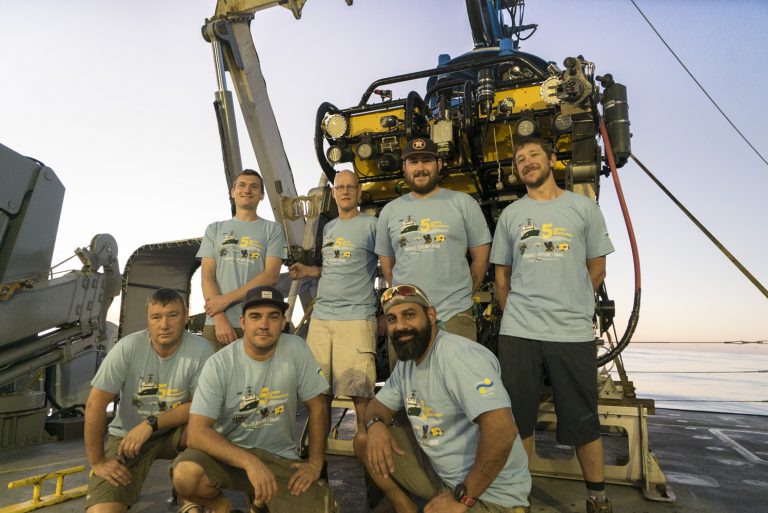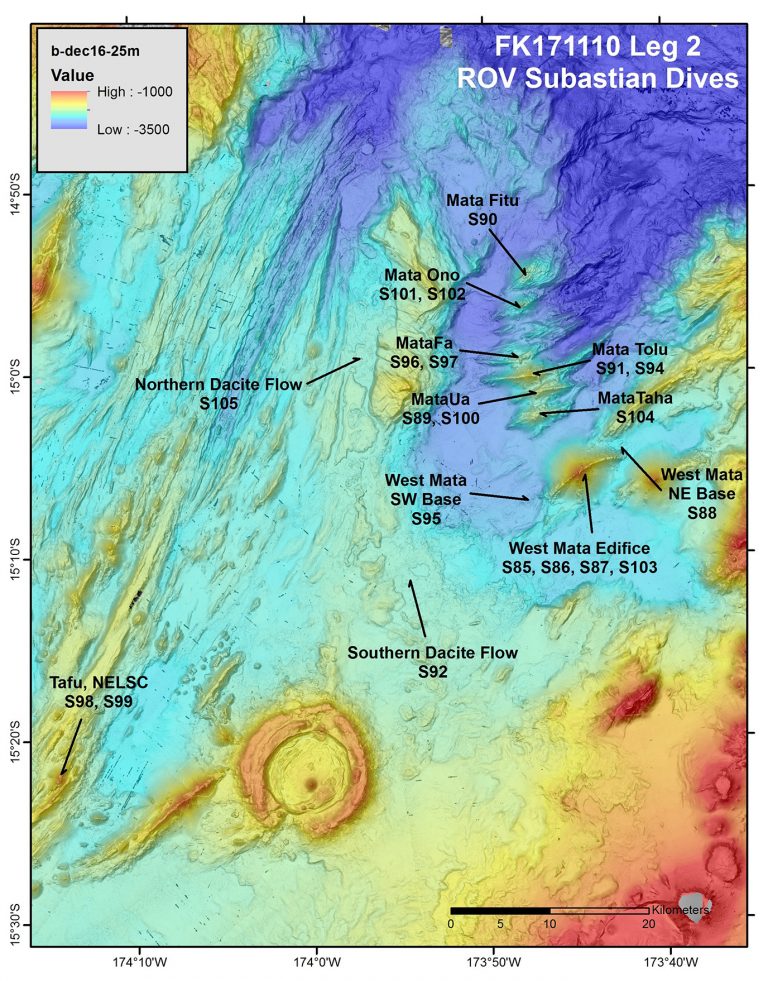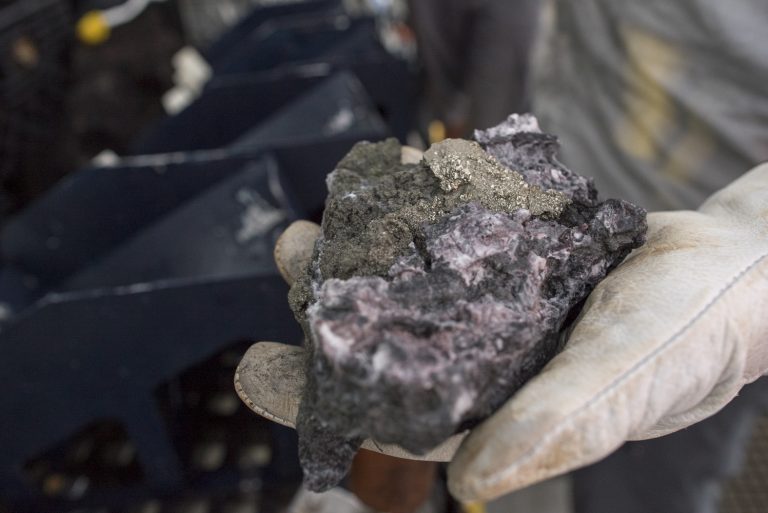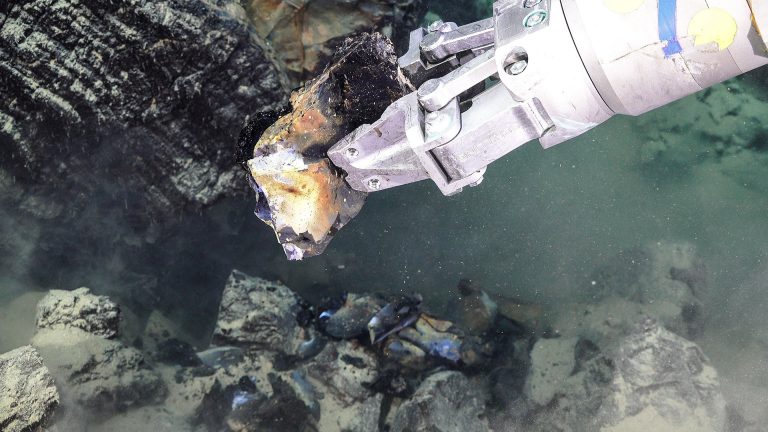The swell seems invisible, but is clearly revealed by Falkor’s rocking and rolling. It represents no challenge for the experienced crew and by the end of the day, ROV SuBastian is safely back on the aft deck after twelve hours of exploring the sea bottom. While the cloudscape glows a beautiful purple and orange tint, a less appealing sulphuric smell fills the corridors leading to the Wet Lab: the water samples come full of volcanic scents.

Twenty-one ROV dives have provided the on-board multidisciplinary team of experts with bountiful data about these young submarine volcanoes and their recent eruptions, plus their impacts on the ocean. The aim of this research group is to understand the geological, biological, and chemical processes at these seamounts, in a chronological context. By studying the geological and magmatic evolution of each volcano in particular – and of all of them as a group – the scientists are developing a stronger understanding of their volcanic history, how and when they formed and grew, as well as their levels of activity. That motivation, and the relationship to magma generation across a wide array of volcanic sites was the core of this expedition, explains the team’s fixation with rocks, having collected over 350 of them. Vent biology, fluid chemistry, and chimney sampling were also components of the research, clarifying the relationships between volcano history and settings, with the development of hydrothermal systems and hydrothermal ecosystems

The Stage
The northern waters of the Kingdom of Tonga in the NorthEast Lau Basin are some of the most tectonically and volcanically active parts of the planet. There is a high density of active submarine volcanoes in a very small area, including the Mata Volcano Group. Here, the volcanoes erupt several unusual types of magma, including a very hot and rarely observed type known as boninite. The region has the fastest converging subduction zone in the world, the fastest back-arc opening, and significant tearing, rotating and breaking apart in the overriding back-arc plate.
Volcanism and magmatism are one of the most fundamental processes that can happen on any planet: They are not restricted to our planet, as they take place in all the rocky planets of the solar system. Most of the volcanism and magmatism on Earth happens in the oceans, and the type of magmatism that happens under the sea is similar to that of Venus, Mars and Earth’s moon. The images produced by ROV SuBastian do indeed seem otherworldly, and we still know much more about volcanism on land than we do on the seafloor – which is another motivation for this Underwater Fire expedition.
In order to take full advantage of the six weeks of the field-work, the expedition was divided into two legs. During the first, an Autonomous Underwater Vehicle (Sentry) was deployed on six occasions to take high resolution bathymetry to gain a detailed understanding of the different shapes and features of the bottom. The AUV also took pictures and collected sensor data, which provided information about the key locations to study. CTD casts were also conducted to locate particles suspended in the water, taking measurements of the seawater’s properties and chemistry, which allowed the team to detect plumes of active volcanoes or hydrothermal systems. During the second leg, ROV SuBastian was deployed on a series of dives to record high-resolution video observations, collect samples and make chemical and property measurements of the seawater.

Piecing It Together
Each time the team deployed SuBastian to look at the rocky outcrops on the seabed, they did so to observe an extensive spatial range of eruption deposits and gain a deeper understanding of how they are distributed across time in a particular location. In order to do so, the team would identify pieces of material that were representative of the phenomena that they are trying to describe. Each specimen was examined before being collected by the manipulator arms of the ROV. The samples need to be a manageable size, well-preserved, and – in the case of volcanic rocks – glassy: since glass is a material that freezes very quickly on the exterior of a submarine lava flow and it preserves the chemical composition in higher fidelity than the interior of the rock, this is an important characteristic.
“The field work is just the first part when we collect samples of volcanic material. The real work continues back in the lab. We take rocks apart both chemically and physically, in a process designed to tell us what is the chemical composition of the rock, how did it form, and how did it come to be what it is. This will take months to years,” shares Dr. Ken Rubin, Chief Scientist.

Some Highlights
This unique geological setting causes a wide diversity of rock types, some among the rarest on our planet. For instance, until recently experts had only found ancient specimens of boninite. It is a very hot, unusual type of lava, only found in subduction zones. In this region many of the volcanoes erupt exclusively boninite lava.
The team was able to closely observe large flows of a different kind of lava: dacite. Some of the dacite flows here do not seem to be associated with any obvious volcano, and the lava is exhibiting intriguing behaviour, mostly in regards to its fluidity and the large area of seafloor the flows cover: these are some of the largest known dacite lava flows on the planet. Another new observation made on this expedition is that the eruptions of the huge dacite lava flows likely included explosive phases. This is an unexpected find because the force needed to explode under the pressure of more than two kilometers of water is massive.
The team also observed that volcanism is not restricted to the summits of the volcanoes – several have been active at their flanks and bases. The diversity of locations is one exciting future focus of study because it gives researchers an idea how these volcanoes grow and provides information about the internal “plumbing systems” of these geological formations.

A key observation was that even though these volcanoes are very closely-spaced (2 km apart in average), the differences between them are stark. Four of them have hydrothermal systems, yet the style of the hydrothermalism – the shapes and spacing of the chimneys, their height, and the biological communities living on them – is very different from site to site. When it comes to the Mata Volcanoes, West Mata stands out as different from the rest. Because of its recent eruptions, the chemistry of the water around it is completely different from that of a typical high temperature black smoker system. The rest of the Matas exhibit a more common high temperature system, yet there are still many things left to understand. For Instance: “We are really still trying to piece together what the rules are that determine which animals live in each different site. Chemistry has something to do with it for sure, but just looking at the North Matas, we see differences between the animal communities from one site to another – yet the chemistry is really quite similar,” says Dr. David Butterfield, Chemical Oceanographer. Biological interactions, competition, and first colonization are all factors that could also play a role.
21 ROV dives at 11 submarine volcanoes, 350+ Rock samples, 30+ Sulphide samples, 60+ Vent fluid samples, 470+ Biological samples, 12,000+ km2 of seafloor mapped. The amount of data collected during the Underwater Fire expedition is sure to keep the scientists and their teams busy for a long time to come.

